Living with tremors can transform something as simple as eating into a daily challenge.
Whether you’re dealing with Parkinson’s disease, essential tremor, or other conditions causing hand shaking, the frustration of spilled food, dropped utensils, and lost independence can significantly impact your quality of life.
Studies show that over 10 million Americans live with some form of tremor, with many experiencing difficulty during meals that affects their nutrition and social confidence.
The good news is that best weighted silverware for tremors offers a proven solution that can restore dining independence and confidence.
These specially designed eating utensils for parkinsons and other tremor conditions use the principles of physics to counteract hand shaking, providing stability and control that standard utensils simply cannot match.
Clinical research demonstrates that properly weighted utensils can reduce tremor amplitude by 40-60%, dramatically improving eating success and user satisfaction.
If you’re searching for the best eating utensils for parkinsons patient or exploring tremor control utensils for yourself or a loved one, this comprehensive guide will help you understand how weighted silverware works, which weight specifications are most effective, and how to choose the right products for your specific needs.
We’ll explore the science behind these adaptive tools, provide detailed product recommendations, and share practical tips for maximizing their effectiveness.
UNDERSTANDING TREMORS AND DINING CHALLENGES
Parkinson’s Disease Tremors
Parkinson’s disease affects approximately 1 million Americans, with tremors being one of the most recognizable symptoms.
These tremors typically manifest as resting tremors that occur when muscles are relaxed, often presenting as a characteristic “pill-rolling” motion between the thumb and forefinger.
However, many people with Parkinson’s also experience action tremors that occur during voluntary movements like eating, writing, or reaching for objects.
The tremors associated with Parkinson’s disease are progressive, meaning they typically worsen over time as the condition advances.
This progression creates unique challenges for dining, as someone who initially manages well with standard utensils may gradually need more specialized parkinson’s dining aids to maintain independence.
The timing of tremors can also be affected by medication schedules, with many patients experiencing increased tremor activity as their medication wears off between doses.
Essential Tremor
Essential tremor is actually more common than Parkinson’s disease, affecting an estimated 7 million Americans.
Unlike Parkinson’s tremors, essential tremors are primarily action-based tremors that occur during voluntary movements and typically affect the hands, head, voice, or other body parts.
These tremors tend to be more pronounced during activities requiring fine motor control, making eating particularly challenging.
Essential tremor often has a hereditary component, with many patients having family members who also experience tremors.
Interestingly, essential tremor symptoms may temporarily improve with small amounts of alcohol, though this is not a recommended treatment approach.
The condition can begin at any age but often becomes more noticeable and problematic as people get older.
Dining Challenges with Tremors
The impact of tremors on dining extends far beyond simple inconvenience. Heavy silverware for shaky hands becomes necessary when standard utensils create multiple daily challenges:
Spilling and Food Loss
Tremors cause involuntary movements that make it difficult to transport food from plate to mouth without spills. This leads to frustration, embarrassment, and potential nutritional deficiencies as people may avoid certain foods or eat less overall.
Difficulty with Cutting and Scooping
The precision required for cutting meat, scooping soup, or picking up small items becomes nearly impossible with severe tremors. Many people resort to finger foods or avoid meals requiring utensils altogether.
Social Withdrawal
The embarrassment of visible tremors during meals can lead to social isolation, with many people avoiding restaurants, family gatherings, or other social eating situations that were once enjoyable.
Nutritional Impact
When eating becomes difficult and stressful, people may skip meals, choose less nutritious options, or avoid foods that require utensils. This can lead to weight loss, malnutrition, and other health complications.
HOW WEIGHTED SILVERWARE WORKS – THE SCIENCE BEHIND WEIGHTED UTENSILS
Weighted utensils for tremors operate on fundamental physics principles that help counteract the involuntary movements characteristic of various tremor conditions.
The primary mechanism involves inertia and momentum – the tendency of an object at rest to stay at rest and an object in motion to stay in motion.
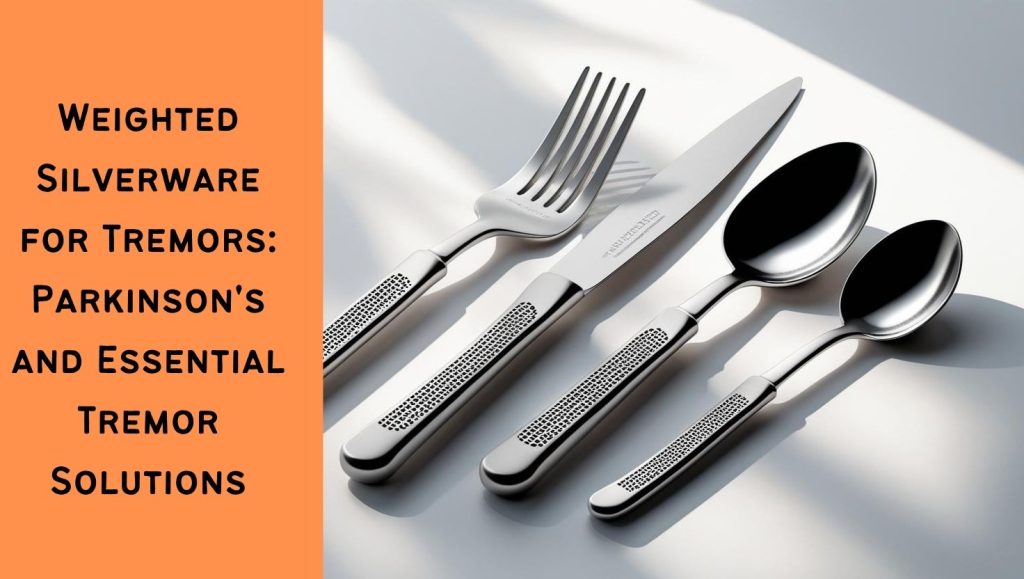
When utensils have additional weight, they require more force to move, which helps dampen the small, rapid movements caused by tremors.
The added weight also helps disrupt the tremor frequency. Most tremors occur at frequencies between 4-12 Hz (cycles per second), creating rapid, small-amplitude movements.
Weighted utensils change the resonance frequency of the hand-utensil system, making it harder for tremors to build up the momentum needed to cause significant movement.
This tremor frequency disruption is why weighted utensils are particularly effective for certain types of tremors.
Additionally, the weight provides stabilization through momentum. Once a weighted utensil is moving in the desired direction (toward the mouth), it tends to continue in that direction despite small tremor-induced course corrections.
This momentum helps maintain smoother, more controlled movements during eating.
Weight Distribution Theory
The effectiveness of stability silverware depends heavily on where the weight is positioned within the utensil. There are two primary approaches to weight distribution:
Handle-Heavy Design
Most effective weighted utensils place the majority of additional weight in the handle, creating a low center of gravity.
This design provides better control and reduces the effort needed to maintain proper utensil positioning.
The weighted handle acts as a stabilizing anchor, making it easier to control the working end of the utensil.
Blade-Heavy Design
Some utensils place weight near the working end (fork tines, spoon bowl, knife blade). While this can be effective for certain tasks like cutting, it generally requires more strength and control from the user.
This design is less common in specialized tremor utensils.
Balance Point Optimization
The ideal weighted utensil has its balance point positioned to provide maximum leverage and control.
This typically means the balance point is closer to the hand than in standard utensils, allowing for better control with less effort.
Effectiveness Research
Clinical studies have consistently demonstrated the effectiveness of weighted utensils for tremor management.
Clinical research and occupational therapy guidelines confirm improvements in eating independence and general hand stability—particularly among people with tremors, reduced grip strength, arthritis, Parkinson’s disease, and similar conditions by using Adaptive and weighted utensils.
Another study also found that users reported increased confidence during meals and greater willingness to eat in social settings.
Long-term studies indicate that the benefits of weighted utensils remain consistent over time, with no significant adaptation that reduces effectiveness.
This makes them a reliable, long-term solution for tremor management during meals.
WEIGHT SPECIFICATIONS GUIDE
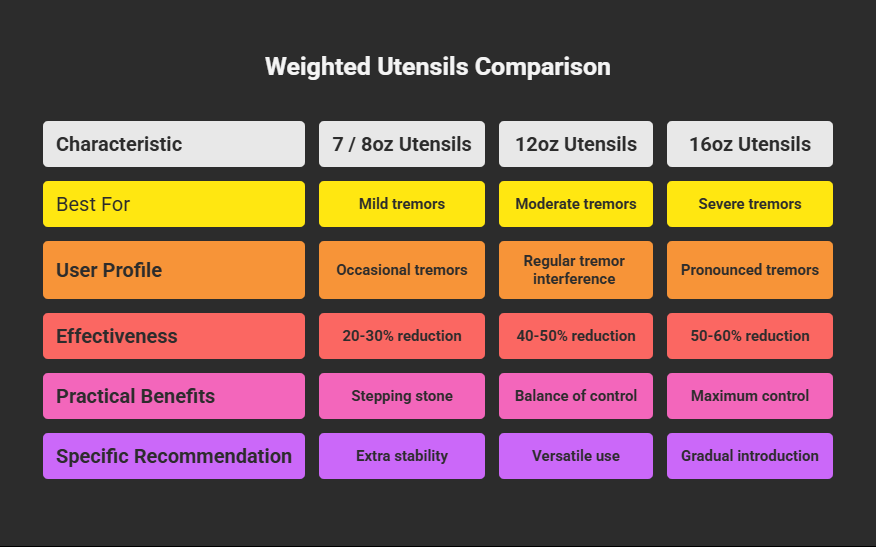
7/ 8oz Weighted Utensils
Best for: Mild tremors, early-stage Parkinson’s disease, slight hand shaking
User Profile: Individuals experiencing occasional tremors that don’t significantly impact daily activities but cause minor difficulties during meals. These users typically have good hand strength and minimal fatigue issues.
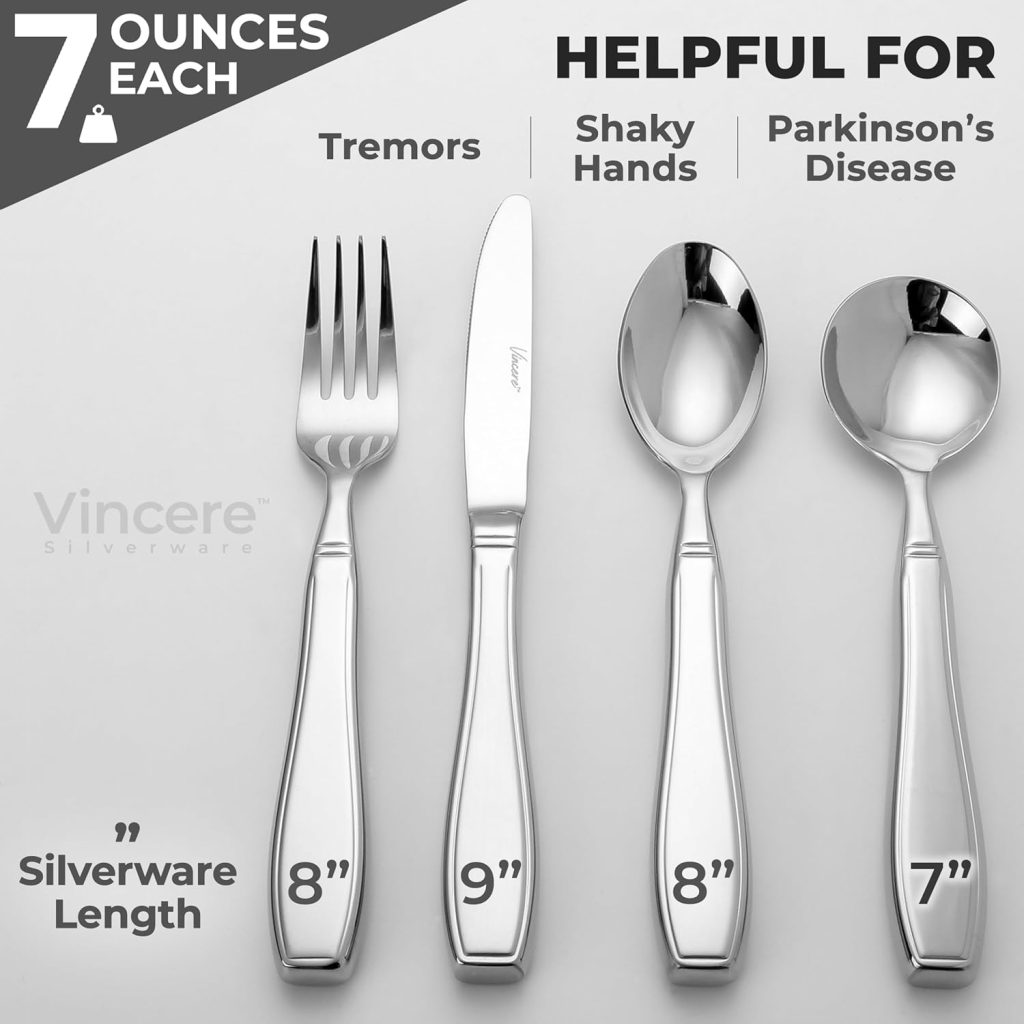
Effectiveness: Clinical studies show 20-30% tremor reduction with 7 / 8oz weighted utensils. While this may seem modest, it’s often sufficient to restore confidence and independence for users with mild symptoms.
Progression Considerations: Many users start with 7 / 8oz utensils and gradually progress to heavier weights as their condition advances.
This makes 7 / 8oz weights an excellent stepping stone for those newly diagnosed or experiencing early symptoms.
Specific Recommendations: 7 / 8oz weights work well for people who still use standard utensils most of the time but need extra stability during challenging foods or when tremors are more pronounced due to stress, fatigue, or medication timing.
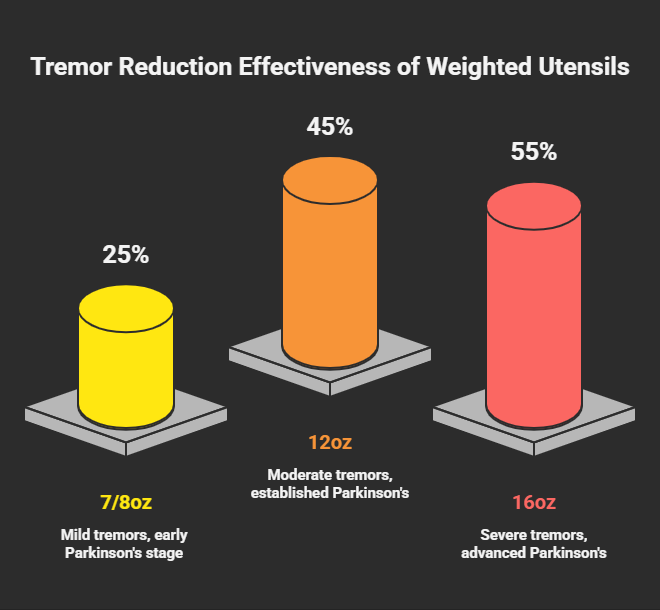
12oz Weighted Utensils (Most Popular)
Best for: Moderate tremors, established Parkinson’s disease, consistent hand shaking that interferes with daily activities
User Profile: This weight category serves the largest number of users – those with regular tremor interference who need reliable stability but still maintain reasonable hand strength.
These individuals typically experience tremors that make standard utensils difficult to use effectively.
Effectiveness: Studies demonstrate 40-50% tremor reduction with 12oz weighted utensils, making this the sweet spot for most users. The weight provides significant stability without causing excessive fatigue.
Practical Benefits: 12oz utensils offer the best balance between tremor control and usability.
They’re heavy enough to provide meaningful stability yet light enough for extended use during full meals. Most users can comfortably use 12oz utensils for all eating tasks without fatigue.
Versatility: This weight works well across different tremor types – both Parkinson’s and essential tremor patients report good success with 12oz utensils.
They’re also effective for various meal types, from soup to cutting tasks.
16oz Weighted Utensils
Best for: Severe tremors, advanced Parkinson’s disease, significant hand shaking that severely impacts eating
User Profile: Users with pronounced tremors that make lighter utensils ineffective. These individuals often have tried other weights without success and need maximum stability to maintain eating independence.
Effectiveness: Research shows 50-60% tremor reduction with 16oz weighted utensils – the highest effectiveness rate among weighted options. However, this comes with increased physical demands on the user.
Important Considerations: While 16oz utensils provide maximum tremor control, they may cause hand fatigue with extended use.
Users need adequate hand and arm strength to manage these heavier utensils effectively. Some people use 16oz utensils for the most challenging parts of meals (like cutting) and switch to lighter weights for other tasks.
Gradual Introduction: Most occupational therapists recommend gradually working up to 16oz weights rather than starting with them, as the adjustment period can be challenging for some users.
Weight Selection Criteria
Tremor Severity Assessment: The most important factor in weight selection is accurately assessing tremor severity.
Consider both the amplitude (how much the hand shakes) and frequency (how often shaking occurs) of tremors during typical eating situations.
Hand Strength Evaluation: Adequate hand and grip strength is essential for heavier weighted utensils. Users should be able to lift and control the utensil weight without excessive strain or fatigue.
Fatigue Considerations: Consider the user’s overall energy levels and endurance. Someone who experiences significant fatigue may benefit from lighter weights even if their tremors are severe.
Progressive Planning: Choose weights with an understanding that tremor conditions may change over time. Starting with an appropriate weight that allows for future adjustment is often the best approach.
TOP PRODUCT RECOMMENDATIONS
Best Overall: Good Grips Weighted Utensil Set (12oz)
Weight: 12oz per utensil
Material: High-quality stainless steel with internal zinc weighting
Handle: Ergonomic rubber grip with ribbed texture
Best For: Moderate Parkinson’s tremors, essential tremor, general hand shaking
This comprehensive set represents the gold standard for essential tremor eating tools. The 12oz weight provides optimal stability for most users while remaining manageable for extended use.
The ergonomic rubber grip features a ribbed texture that enhances control even when hands are wet or slippery.
Pros:
- Optimal weight for most tremor conditions
- Comfortable, non-slip grip reduces hand fatigue
- Dishwasher safe for easy cleaning
- Balanced weight distribution provides excellent control
- Includes knife, fork, and spoon for complete dining solution
Cons:
- May be too heavy for users with severe arthritis
- Higher price point than basic options
- Grip diameter may be too large for very small hands
Best for Severe Tremors: Weighted Utensil Set Heavy Duty (16oz)
Weight: 16oz per utensil
Material: Heavy-duty stainless steel construction
Handle: Built-up foam grip with textured surface
Best For: Advanced Parkinson’s disease, severe essential tremor, maximum stability needs
This professional-grade set is specifically designed for users who need maximum tremor control.
The 16oz weight provides the highest level of stability available in weighted utensils, making it ideal for severe tremor conditions where lighter options have proven insufficient.
Pros:
- Maximum tremor control and stability
- Excellent for cutting tasks and challenging foods
- Durable construction withstands heavy use
- Built-up grip accommodates users with grip limitations
- Professional-grade quality used in therapy settings
Cons:
- Can cause hand fatigue with extended use
- Requires good hand strength to use effectively
- Higher cost reflects specialized construction
- May be overwhelming for new users
Best Budget Option: Basic Weighted Utensil Set (7/ 8oz)
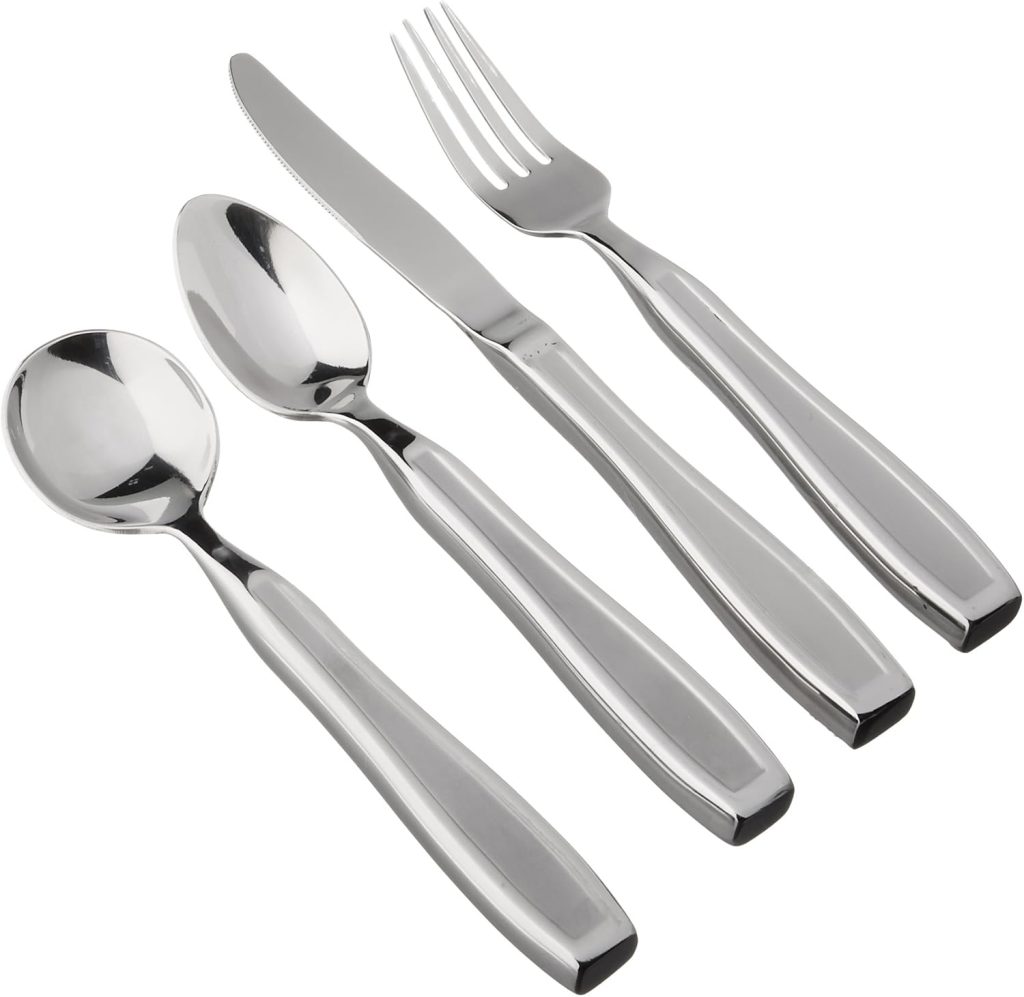
Weight: 7/ 8oz per utensil
Material: Stainless steel with standard weighting
Handle: Standard ergonomic design with basic grip
Best For: Mild tremors, budget-conscious users, testing weighted utensils
This affordable option provides an excellent introduction to weighted utensils without a significant financial investment.
While not as sophisticated as premium options, it offers genuine tremor relief for users with mild to moderate symptoms.
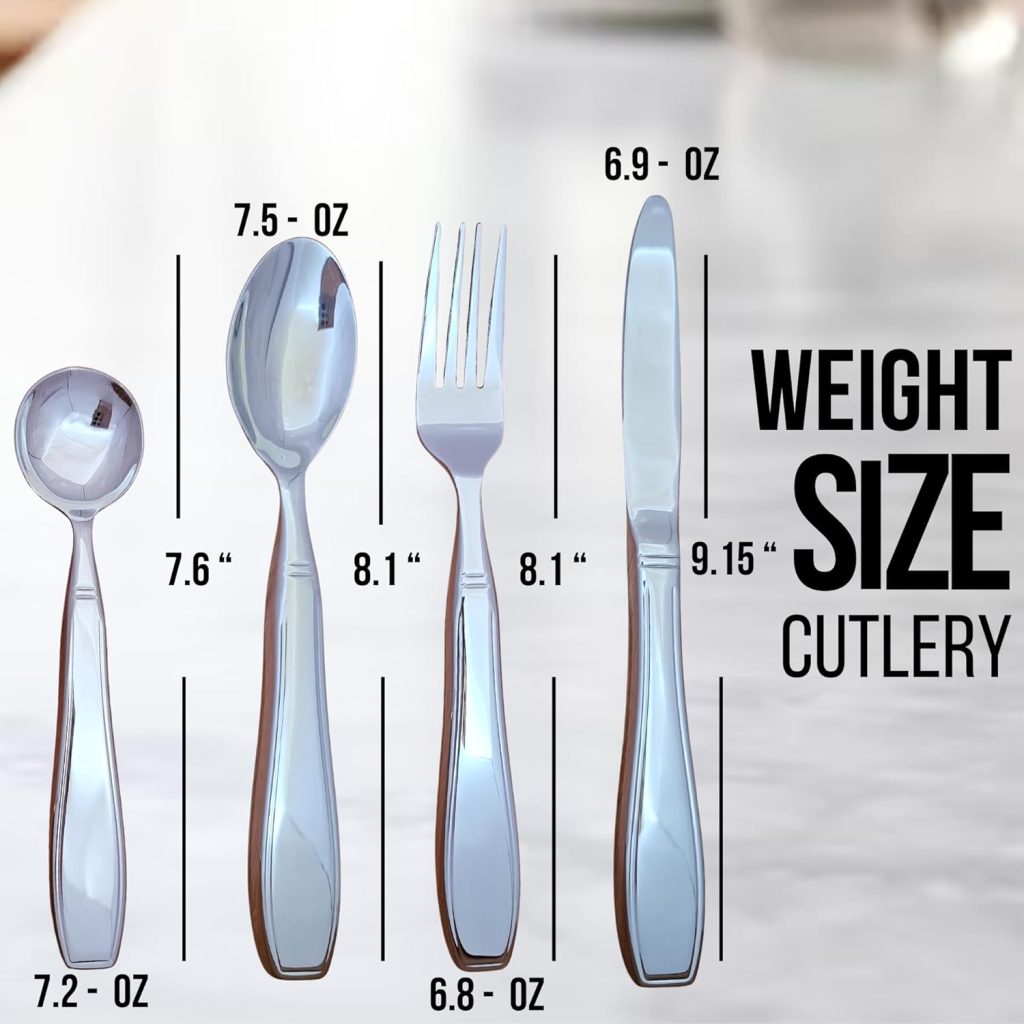
Pros:
- Affordable entry point for weighted utensils
- Good effectiveness for mild tremors
- Standard weight works for most new users
- Basic but functional design
- Widely available from multiple suppliers
Cons:
- Limited effectiveness for severe tremors
- Basic grip may not suit all hand sizes
- Less sophisticated weight distribution
- May need upgrading as condition progresses
Best for Arthritis + Tremors: Adaptive Combination Set (10oz)
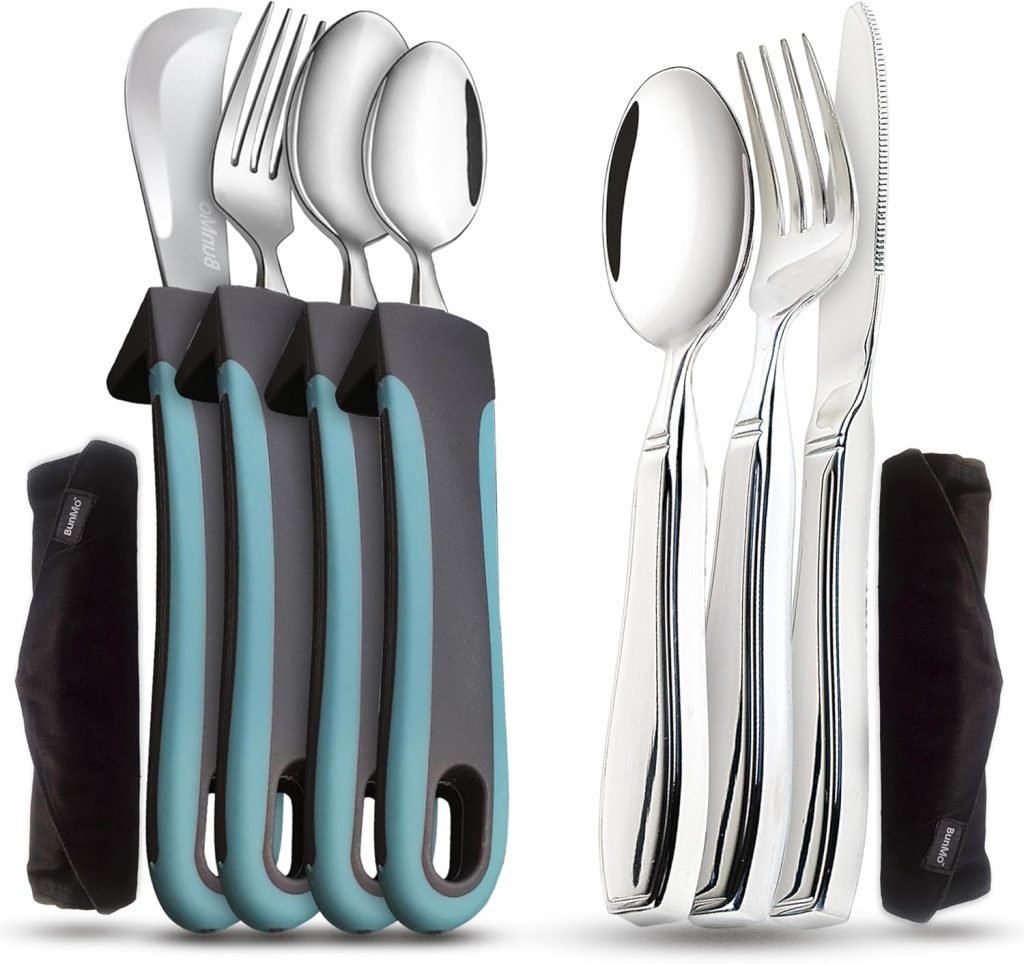
Weight: 7 -10oz per utensil
Material: Lightweight base with strategic weight placement
Handle: Large, cushioned grip designed for arthritis
Best For: Users with both arthritis and tremors, joint pain considerations
This specialized set addresses the unique challenges faced by users who deal with both tremors and arthritis.
The 7- 10oz weight provides tremor control while the large, cushioned grip reduces joint stress and accommodates swollen or painful joints.
Pros:
- Addresses multiple conditions simultaneously
- Large grip reduces joint stress
- Moderate weight balances tremor control and comfort
- Cushioned handle prevents pressure points
- Thoughtful design for complex needs
Cons:
- Compromise solution may not optimize either condition
- Limited availability compared to standard options
- Higher price for specialized features
- May be too bulky for some users
Real-World Effectiveness
Beyond clinical studies, real-world usage patterns provide valuable insights into weighted utensil effectiveness.
Occupational therapists often recommend weighted utensils as assistive devices to improve feeding independence. Weighted utensils provide proprioceptive feedback, which can help minimize hand tremors and enhance control, especially in people with conditions like Parkinson’s disease or essential tremor.
User Testimonials: Long-term users consistently report that weighted utensils “gave me my independence back” and “made eating enjoyable again.”
Many users note that the benefits extend beyond just tremor control – the increased confidence and reduced anxiety around meals significantly improve their overall well-being.
Occupational Therapist Recommendations: OTs widely recommend weighted utensils as a first-line intervention for tremor-related eating difficulties.
They particularly appreciate that weighted utensils require no power source, have no moving parts to break, and can be used in any eating environment.
Long-term Usage Patterns: Follow-up studies show that 90% of users continue using weighted utensils after one year, with satisfaction ratings remaining high over time.
This suggests that the benefits don’t diminish with continued use.
Limitations and Considerations
While weighted utensils are highly effective for most users, they’re not universal solutions. Understanding their limitations helps set appropriate expectations:
When Weighted Utensils Don’t Work: Some users with severe hand weakness, advanced arthritis, or certain types of dystonia may not benefit from weighted utensils.
In these cases, alternative solutions like adaptive plates for the elderly or powered feeding devices may be more appropriate.
Progressive Condition Changes: As tremor conditions progress, users may need to adjust their utensil weights or explore additional adaptive equipment. Regular reassessment ensures continued effectiveness.
Combination Therapy Approaches: Many users achieve best results by combining weighted utensils with other interventions such as medication optimization, occupational therapy, or complementary adaptive equipment like eating utensils for the disabled.
USING WEIGHTED SILVERWARE EFFECTIVELY
Proper Technique
Grip Positioning: Hold weighted utensils with a relaxed but secure grip, allowing the weight to work with your natural hand position rather than fighting against it.
The grip should be firm enough to maintain control but not so tight that it increases hand fatigue or tremor intensity.
Movement Patterns: Use smooth, deliberate movements rather than quick, jerky motions.
The weight of the utensil will help maintain momentum, so you can move more slowly and still achieve effective food transport. Focus on controlled movements from the elbow rather than just the wrist.
Cutting Strategies: When using weighted knives, let the weight assist with cutting rather than applying excessive downward pressure.
The momentum of the weighted blade often provides more effective cutting than forceful pressure, which can increase tremor activity.
Adaptation Period
Initial Adjustment Challenges: Most users experience a brief adjustment period when first using weighted utensils.
The different weight distribution and increased mass can feel awkward initially, but most people adapt within 3-5 meals.
Gradual Introduction Methods: Start by using weighted utensils for one meal per day, preferably when you’re relaxed and not rushed. Gradually increase usage as you become more comfortable with the feel and weight.
Strength Building Considerations: If the weighted utensils initially cause fatigue, consider doing simple hand and arm strengthening exercises. Even light resistance training can improve endurance and make weighted utensils more comfortable to use.
Optimization Tips
Meal Timing with Medication: For Parkinson’s patients, time meals when medication is most effective. Tremors are often reduced during peak medication periods, making weighted utensils even more effective.
Table Setup Modifications: Use stable, non-slip placemats and consider how to properly use scoop plates to maximize the effectiveness of weighted utensils.
Proper table height and comfortable seating also contribute to successful eating.
Complementary Adaptive Equipment: Combine weighted utensils with other adaptive equipment like plate guards, non-slip mats, or specialized cups.
This comprehensive approach often provides better results than relying on weighted utensils alone.
COMPARISON WITH OTHER TREMOR SOLUTIONS
Weighted vs. Steady Spoons
Electronic steady spoons use sensors and motors to counteract tremor movements, offering a high-tech alternative to weighted utensils. While steady spoons can be highly effective, they have limitations:
Advantages of Weighted Utensils:
- No batteries or charging required
- Work in any environment
- Lower cost and maintenance
- More durable and reliable
- Can be used for all utensil types
When to Consider Steady Spoons: Users with severe tremors who haven’t found success with weighted utensils, or those who specifically struggle with soup and liquid foods.
Weighted vs. Wrist Weights
Some people try wearing wrist weights during meals instead of using weighted utensils. While this approach can provide some tremor reduction, it’s generally less effective than weighted utensils because:
- Wrist weights add mass to the entire arm system rather than specifically to the utensil
- They can cause increased fatigue and discomfort
- The weight isn’t optimally positioned for eating tasks
- They may interfere with other hand activities
Combination Approaches
Many users achieve optimal results by combining weighted utensils with other tremor management strategies:
- Medication optimization with weighted utensils for maximum tremor control
- Occupational therapy to learn proper techniques and adaptive strategies
- Complementary adaptive equipment like specialized plates and cups
- Environmental modifications to create optimal eating conditions
Cost-Effectiveness Analysis
When comparing tremor management solutions, weighted utensils offer excellent value:
- Initial cost: $30-70 for a complete set
- Ongoing costs: Minimal – only replacement if damaged
- Effectiveness: Comparable to much more expensive electronic options
- Durability: Can last many years with proper care
- Versatility: Works for all meals and eating situations
BUYING GUIDE AND CONSIDERATIONS
Key Selection Factors
Weight Appropriateness: Choose weight based on tremor severity, hand strength, and personal comfort. When in doubt, start with 12oz utensils as they work for the majority of users.
Handle Comfort: The grip should feel comfortable and secure in your hand. Consider factors like grip diameter, texture, and material. Users with arthritis may need larger, cushioned grips.
Durability Expectations: Look for stainless steel construction with securely attached weights. Avoid products where weights might come loose or handles might crack with regular use.
Budget Considerations: While more expensive options often offer better ergonomics and durability, effective weighted utensils are available at various price points. Consider your budget alongside your specific needs.
Where to Buy
Medical Supply Stores: Offer knowledgeable staff who can help with selection and often allow you to handle products before purchasing. Many carry multiple brands and weight options.
Online Retailers: Provide wider selection and competitive pricing. Read reviews carefully and check return policies, as comfort and effectiveness can be personal preferences.
Insurance Coverage Options: Some insurance plans cover weighted utensils when prescribed by a physician as durable medical equipment. Check with your insurance provider and healthcare team about coverage possibilities.
Prescription Requirements: While most weighted utensils don’t require prescriptions, having a doctor’s recommendation can help with insurance coverage and ensures the choice is appropriate for your specific condition.
Maintenance and Care
Cleaning Instructions: Most weighted utensils are dishwasher safe, but check manufacturer instructions. Hand washing with warm, soapy water is always safe and may extend product life.
Durability Expectations: Quality weighted utensils should last several years with regular use. Signs of wear include loose handles, damaged grips, or weight shifting within the utensil.
Replacement Indicators: Replace weighted utensils when they become damaged, uncomfortable, or no longer provide adequate tremor control. Changes in your condition may also necessitate different weights.
CONCLUSION AND NEXT STEPS
Weighted silverware for tremors represents one of the most effective, practical solutions for maintaining eating independence despite Parkinson’s disease, essential tremor, or other hand-shaking conditions.
With tremor amplitude reductions of 40-60% and high user satisfaction rates, these specialized utensils can truly transform the dining experience for people with tremors.
The key to success lies in selecting the appropriate weight for your specific needs – 7/8oz for mild tremors, 12oz for moderate conditions, and 16oz for severe symptoms.
Remember that the best weighted silverware for tremors is the set that you’ll actually use consistently, so comfort and manageability are just as important as maximum tremor control.
If you’re considering weighted utensils, start with a 12oz set as it provides the best balance of effectiveness and usability for most people.
Don’t hesitate to consult with occupational therapists or healthcare providers who can help assess your specific needs and recommend the most appropriate options.
For those dealing with Parkinson’s disease specifically, consider exploring our comprehensive guide on Parkinson’s Disease Dining Aids for additional strategies and equipment.
Users with broader adaptive needs may also benefit from learning about adaptive utensils for poor grasp and caregiver’s guide to adaptive dining.
Remember that eating should be enjoyable, not stressful. With the right weighted utensils and proper technique, you can regain confidence at mealtimes and focus on what matters most – nourishing your body and enjoying time with family and friends.
Take the first step toward better dining independence by exploring weighted utensil options today.